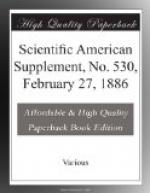The time has now come when this search can be profitably undertaken by any observer having the rare combination of time, enthusiasm, and the necessary appliances. Strongly marked developments in astronomical photography have been effected since this optical search was conducted; and the capacity of the modern dry-plate for the registry of the light of very faint stars makes the application of this method the shortest and surest way of detecting any such object. Nor is this purely an opinion of my own. But the required apparatus would be costly; and the instrument, together with the services of an astronomer and a photographer, would, for the time being, be necessarily devoted exclusively to the work. While, however, the photographic search might have to be ended with a negative result, in so far as the trans-Neptunian planet is concerned, there would still remain the series of photographic maps of the region explored, and these would be of incalculable service in the astronomy of the future.
In the latter part of the paper alluded to above, I stated the speculative basis upon which I restricted the stellar region to be examined; also the fact that between November of 1877 and March of 1878 I was engaged in a telescopic scrutiny of this region, employing the twenty-six inch refractor of the Naval Observatory. For the purposes contemplated I had no hesitation in adopting the method of search whereby I expected to detect the planet by the contrast of its disk and light with the appearance of an average star of about the thirteenth magnitude. A power of 600 diameters was often employed, but the field of view of this eye-piece was so restricted that a power of 400 diameters had to be used most of the time. I say, too, that, “after the first few nights, I was surprised at the readiness with which my eye detected any variation from the average appearance of a star of a given faint magnitude; as a consequence whereof my observing book contains a large stock of memoranda of suspected objects. My general plan with these was to observe with a sufficient degree of accuracy the position of all suspected objects. On the succeeding night of observation they were re-observed; and, at an interval of several weeks thereafter, the observation was again verified.” Subjoined to the original observations are printed these verifications in heavy-faced type.
In conducting the search, the plans were several times varied in slight detail, generally because experience with the work enabled me to make improvements in method. Usually, I prepared every few days a new zone chart of the region over which I was about to search; and these charts while containing memoranda of all the instrumental data which could be prepared beforehand, were likewise so adjusted with reference to the opposition-time of the planet as to avoid, if possible, its stationary point. The same thing, too, was kept in mind in selecting the times of subsequent observation. Notwithstanding this precaution, however, it would be well if some observer who has a large telescope should now re-examine the positions of these objects.




